Reserve Bank of Australia Annual Report – 1978 International and Domestic Economic Developments
Overseas Economic Conditions
11 Overseas Economic Conditions — 1


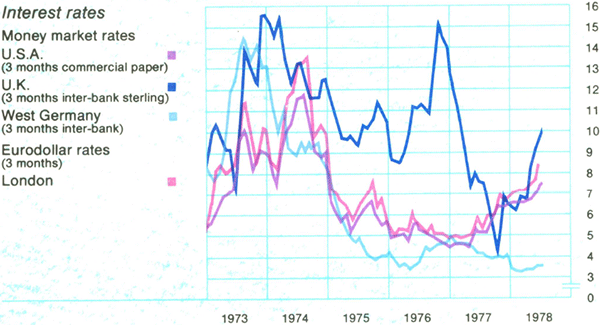
International reserves rose strongly in 1977, with the increased external deficit of the USA leading central banks to mop up surplus US dollars. Creation of reserves slowed early in 1978.
Domestic monetary growth in the world's economies slowed a little in 1977 from a high rate in 1976.
Interest rate differentials have reflected the rise in US rates and the tendency for rates in countries with stronger currencies to fall. Euro-dollar rates have risen with US domestic rates. The decline in UK interest rates reversed sharply in late 1977.
12 Overseas Economic Conditions — 2




Economic growth in the major western economies slowed in 1977, especially in the second half. Indications are that there was not much overall improvement in the first half of 1978.
Despite substantial improvement in the USA, unemployment in the OECD area remained high through 1977/early 1978.
Growth in consumer prices was no lower in 1977 as a whole. Inflation edged down in late 1977, but moved higher in early 1978.
Growth in wages slowed further in 1977 but, with output sluggish, unit labour costs rose sharply in many countries.
13 Overseas Economic Conditions — 3



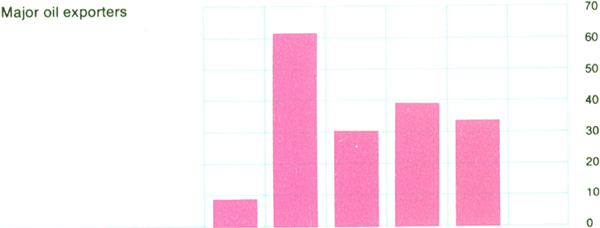
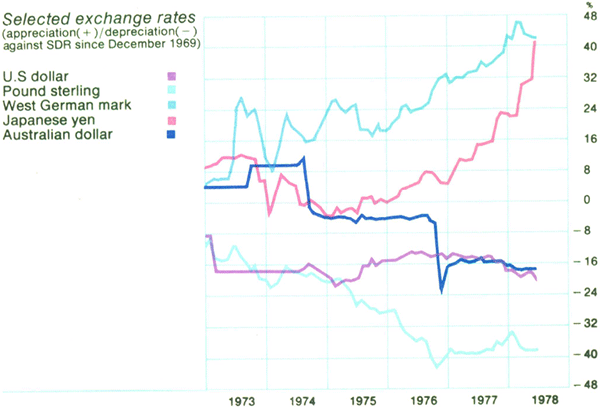
Slower growth in world activity reflected in a step down in the growth of world trade in 1977; the slower growth rate of trade appears to have continued into 1978.
The worsening position of the USA underlay the increased current account deficit of OECD countries in 1977. The deficit of the less developed economies also rose slightly, while the surplus of the major oil exporters fell. The external imbalances of the OECD countries and the major oil exporters may have lessened in early 1978, but the deficit of the less developed countries may have increased.
The large imbalances on current account had their counterpart in high levels of international financing. The liquid state of Euro-currency markets led to intensified competition between international banks, and finance was readily available to most borrowers through the second half of 1977 and into 1978.
Against a background of large payments imbalances and liquid international funds markets, foreign exchange markets have been unsettled. The US dollar weakened through late 1977/early 1978. After steadying temporarily in April, the US dollar again fell sharply, particularly against the yen, in May and June.
Australia's Balance of Payments
14 Australia's Balance of Payments




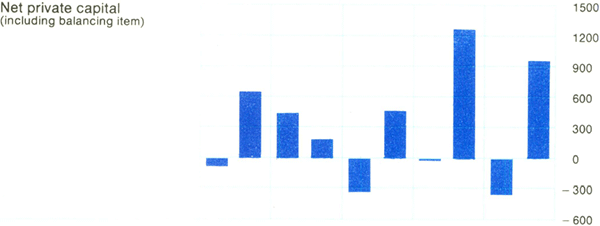

Import prices rose much faster than export prices in 1977/78 and, despite a sharp drop in the quantity of goods imported, the trade surplus was noticeably smaller.
The net invisibles deficit rose further in 1977/78. Dividend and interest payments abroad – including interest on official loan raisings – rose strongly; so did retained earnings of foreign-owned enterprises.
After a better first half, the current account weakened in the six months to June 1978 and, for 1977/78 as a whole, showed a deficit nearly one-quarter greater than in the previous financial year.
The large programme of overseas loan raisings ($1.8 billion gross; $1.6 billion net), produced a strongly positive government capital account in 1977/78.
After the influx of private capital following the November 1976 devaluation, there was a net apparent outflow in the first half of 1977/78, but a strong inflow in the final six months.
There was an overall balance of payments deficit early in 1977/78, but a surplus in the final six months. For the full year the balance of payments deficit was a little larger than in 1976/77.
The Domestic Economy
15 Product and Spending
(1974/75 prices – seasonally adjusted annual rates)







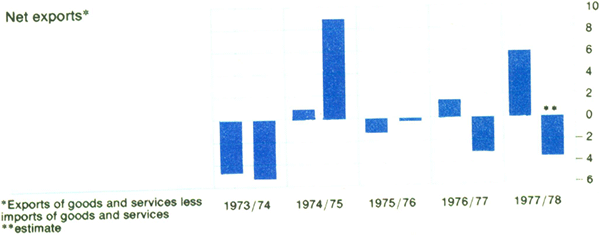
Although growth in final spending apparently held firm, total product grew less strongly in 1977/78. Product growth may have been stronger in the second half of the year.
The rise in non-farm product – over 90 per cent of total GDP – in 1977/78 was largely in the non-industrial sectors. Industrial production apparently was flat.
Farm product fell in 1977/78 to about the average level of the previous four years.
Public spending on both consumption and capital goods was higher in 1977/78; growth seems to have been fairly solid in both halves of the year.
Private consumption – equivalent to about three-fifths of total product – grew moderately in 1977/78.
Private investment in dwellings fell in 1977/78. Business investment in both plant and equipment, and building and structures, grew strongly.
There was a shedding of stocks – especially farm – in 1977/78, with the falls apparently concentrated in the first half.
With the sharp drop in imports, the quantities of goods and services exported in 1977/78 exceeded those imported by a greater margin than in 1976/77.
16 Labour Market
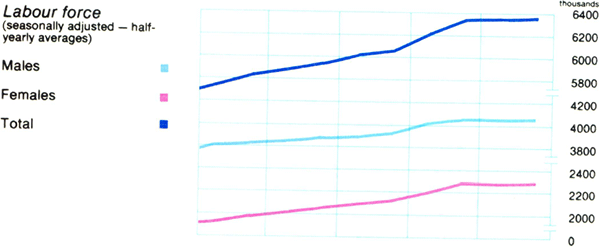



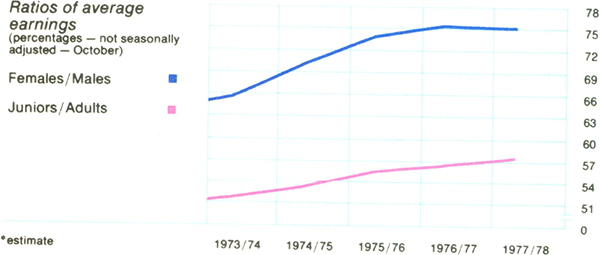
With slightly lower participation rates, the labour force in 1977/78 grew more slowly than in 1976/77.
Civilian employment was little changed in 1977/78, at levels below those of 1974. Female employment rose again in 1977/78; male employment fell a little further. Private employment fell again, with a relatively more pronounced fall in employment in manufacturing; public employment rose.
The labour force expanded faster than employment in 1977/78, and unemployment rose further. Unemployment rates of adults rose relatively more than those of juniors.
Real pre-tax earnings, as indicated by deflating average weekly earnings by the price deflator for private consumption, may have risen slightly in 1977/78.
Since early 1975, wage indexation decisions have been the major influence on changes in money wages. The form of the wage case decisions in 1977/78 did not compress relativities to the extent of some decisions in earlier years.
17 Incomes, Costs and Prices
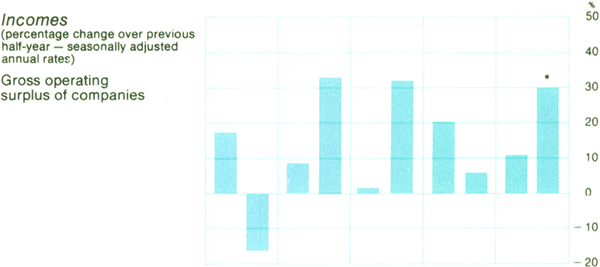




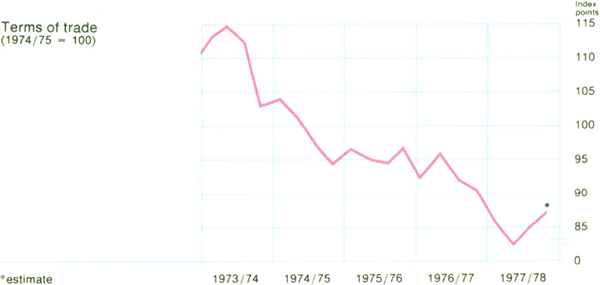
Despite a stronger second half performance, company profits rose a little more slowly in 1977/78 than in the previous twelve months.
Wages, salaries and supplements also grew less in 1977/78. With employment flat, growth in average weekly earnings, and wages, salaries and supplements, were similar. Disposable personal income rose a little faster than gross earnings.
Growth in labour costs per unit of output may have slowed a little more noticeably in 1977/78.
The consumer price index rose by 7.9 per cent between the June quarters of 1977 and 1978, compared with 13.4 per cent over the previous twelve months. The rise in the non-farm GDP deflator over 1977/78 seems likely to have been similar to the 8.4 per cent recorded in 1976/77.
Australia's terms of trade (the ratio of export prices to import prices) generally have moved adversely since the commodity boom of 1973; however, there may have been some reversal in the first half of 1978.